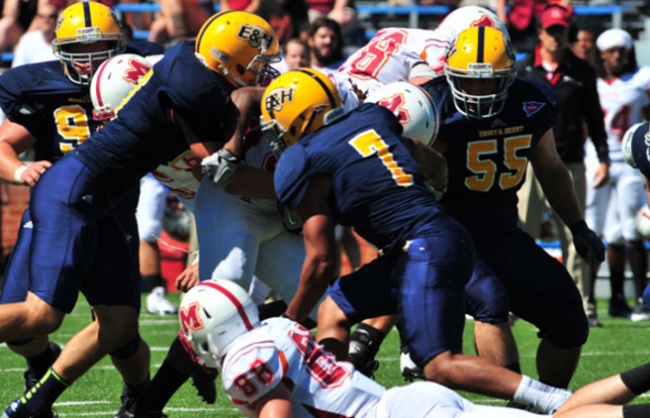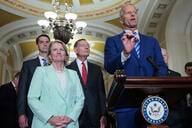You have /5 articles left.
Sign up for a free account or log in.

Emory and Henry College's football team
Emory and Henry College
The National Collegiate Athletic Association’s Division III Committee on Infractions last month placed Kalamazoo College on three years’ probation for violating rules that prohibit the division’s members from awarding financial aid based on athletic ability. For five years, the college considered athletic participation as a factor when determining aid for prospective students, meaning that 567 students received aid packages based on their athletic skill.
While Division III colleges are allowed to weigh athletic considerations in deciding whom they admit, the rules adopted by the division's members bar them from doing so when packaging financial aid. But in the last decade, Kalamazoo has been joined by dozens of other Division III institutions in violating what is frequently referred to as the “bedrock principle” of the division, according to an analysis by Inside Higher Ed of the NCAA's records.
The number of violations points to either lasting confusion over the division's longstanding rules or, fueled by increasing pressure to win, a continuing disagreement over one of its core philosophies.
“The vast majority of cases that are adjudicated by us involve some form or fashion of a financial aid violation,” Jon Duncan, the NCAA’s vice president of enforcement, said. “Not all of them, but the vast majority. At the same time, I don’t hear most schools complaining about the underlying dialogue. They understand that this is foundational.”
Yet the number of those cases seems to be increasing, according to the NCAA’s database of what the association considers to be “major infractions.”
Last year, Rose-Hulman Institute of Technology was found to have awarded nearly $40,000 in financial aid based on athletics, and Emory and Henry College was found to have awarded nearly $80,000 to 27 athletes using athletic criteria. In 2014, the University of Wisconsin at Superior was found to have awarded 196 athletic-based scholarships totaling $393,575 between 2008 and 2013. During that same time period, Denison University offered impermissible financial aid ranging from $1,443 to $9,000 per year to 24 athletes.
Between 1953 and 2006, according to the NCAA's major infractions database, Division III had 13 major violations involving financial aid. In the decade since, there have been more than two dozen cases.
The major infractions database does not include more minor violations, what the NCAA calls "secondary infractions," meaning the total number of financial aid infractions is even higher. Division III institutions are required to use an annual reporting process to compare the financial aid packages of freshman and transfer athletes with the aid packages of freshman and transfer nonathletes. The most recent NCAA report about this process found that between 2005 and 2014, 61 Division III institutions considered athletic ability when packaging financial aid.
Dan Dutcher, president of Division III, said he believes many institutions that are breaking the rules are doing so inadvertently. At Kalamazoo, the college's provost said the "intent was to treat all students -- the musicians, the artists, the student leaders, the athletes -- fairly,” not to gain a completive advantage on other Division III teams.
“I think there’s a lack of understanding, especially on the financial aid and admissions side of the house, of the practical implications of the rule,” Dutcher said. “Practically speaking, there’s still some confusion about how that must be applied. I don’t think among our membership there is a lack of belief regarding the rules.”
That belief hasn’t been as clear in recent years. With 444 institutions, Division III is the NCAA’s largest competitive level. Its members are alike in their official financial aid policies, but for many institutions that’s where the similarities end. Members include midsize branch campuses of public universities and small independent colleges, institutions with 20,000 students and ones with fewer than 500.
Nearly a decade ago -- and around the time that the number of major infractions cases began rising -- differences in both size and opinion nearly split the division in two. Ultimately, the division’s members decided to stay together, but NCAA surveys have revealed that some of those disagreements still remain.
A 2008 survey found that nearly two-thirds of members said “consideration of leadership in athletics (e.g., team captain) in the awarding of financial aid should be allowed provided it is consistent with the consideration of leadership in other student activities.” A 2013 survey found that the desire for change has waned somewhat, though about half of members still said they disagreed that “the current prohibition of considering leadership in athletics (e.g., team captain) in the awarding of financial aid to student-athletes is appropriate.”
Considerably fewer members -- 21 percent -- said the NCAA needed to provide more education about financial aid rules.
In the years since the two surveys and the discussion of splitting up the division, Dutcher said Division III officials have organized several “town hall discussions” and public hearings to discuss considering athletic leadership when packaging financial aid. “And we feel the vast majority still believes in the rule and how it’s applied,” Dutcher said.
Mark Nagel, professor of sports and entertainment management at the University of South Carolina, said the increasing number of violations is likely a mix of institutions making honest mistakes and programs cheating “to get an edge.” Both, he said, are the result of an increasing desire to win within the division.
In the NCAA’s 2008 survey, about 30 percent of Division III members said the “the ultimate measure of success in an athletics program is participation in national championships.” In 2013, more than half of the division agreed with that statement.
“Some Division III teams are moving from the old approach of winning being secondary to it being the primary mission,” Nagel said. “Those schools have looked at athletics and said, ‘If we do a little more here and invest a little more there, we have a chance to win,’ and everyone likes to win. When you start emphasizing winning, though, the natural thing is to start looking for ways to enhance your chances of winning. A lot of the problems we’re seeing now have flowed from this idea.”




